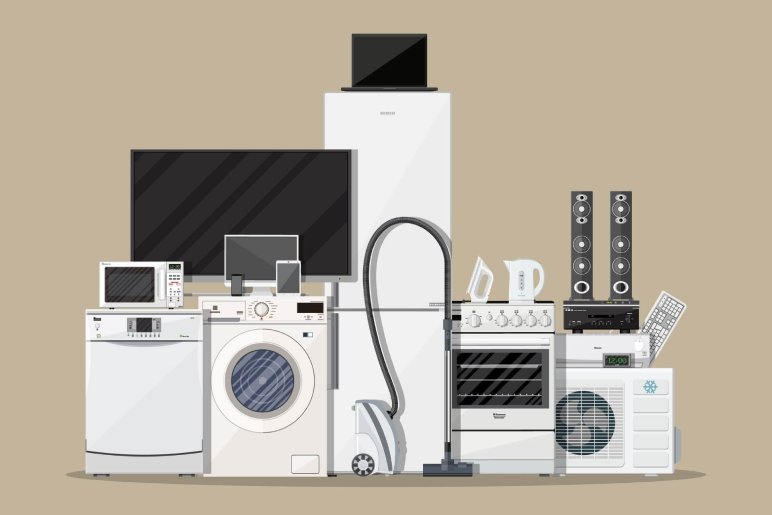The term “white goods” is a collective noun for large domestic appliances used for routine household tasks. Traditionally, these appliances were predominantly white in color, hence the name. However, today, they come in a variety of colors and finishes to suit different interior aesthetics.
White goods vs. brown goods

White goods and brown goods represent distinct categories within the consumer durables market.
White goods encompass large household appliances like refrigerators, washing machines, and ovens, traditionally characterized by their white color (though this is less prevalent today). These items are essential for daily living, providing core functions for food storage, cleaning, and cooking. On the other hand, brown goods refer to consumer electronics such as televisions, radios, computers, and audio systems. Primarily focused on entertainment, communication, and information, brown goods are generally smaller, more portable, and undergo more rapid technological advancements compared to their white goods counterparts.
Durable goods and the Internet of things
Durable goods, traditionally defined by their longevity and substantial value, are undergoing a transformative evolution through the integration of the Internet of Things (IoT). This convergence is creating a new paradigm where physical objects are imbued with digital intelligence, enabling them to collect, analyze, and transmit data. From smart appliances that optimize energy consumption to connected vehicles that provide real-time diagnostics and remote control, the IoT is enhancing the functionality and utility of durable goods. This shift is not only revolutionizing consumer experiences but also driving innovation in manufacturing, supply chain management, and after-sales services. As the IoT ecosystem expands, we can anticipate an increasingly interconnected world where durable goods become active participants in our lives, providing valuable insights and services that go beyond their core functions.
Key Categories of White Goods

White goods can be broadly classified into the following categories:
Kitchen Appliances
- Refrigerators: Refrigerators, indispensable household appliances, preserve food by maintaining low temperatures. They come in various sizes and styles to suit different needs, from compact single-door models for individuals to spacious side-by-side units for large families. With features like frost-free technology, adjustable shelves, and energy-efficient compressors, refrigerators have become essential in modern kitchens, ensuring food freshness and reducing spoilage while offering convenient storage solutions.
- Ovens and Cooktops: Ovens and cooktops are essential components of modern kitchens, each serving distinct culinary functions. Ovens, enclosed heating chambers, excel at baking, roasting, and grilling, providing controlled heat distribution for precise cooking. They come in various sizes and styles, from compact countertop models to large built-in units, accommodating diverse cooking needs. Cooktops, on the other hand, focus on heating pots and pans directly. Available in gas, electric, or induction varieties, they offer immediate heat control for boiling, sautéing, and frying. The choice between gas and electric often hinges on personal preference, with gas providing instant heat response and electric offering even temperature distribution. Many contemporary kitchens seamlessly integrate ovens and cooktops into unified ranges, optimizing space and enhancing culinary versatility.
- Dishwashers: Dishwashers are modern kitchen appliances designed to automate the task of cleaning dishes, glassware, and silverware. They utilize a combination of water, detergent, and high pressure to effectively remove food residue and sanitize items. With various wash cycles and temperature settings, dishwashers offer convenience and efficiency, saving time and effort compared to manual washing. Their energy-efficient designs and eco-friendly features make them a popular choice for households and commercial establishments alike, contributing to a more sustainable lifestyle.
- Microwaves: Microwaves are a type of electromagnetic radiation with wavelengths shorter than radio waves but longer than infrared waves. They fall within the frequency range of approximately 300 MHz to 300 GHz. Microwaves are used in various applications, including radar, satellite communication, and microwave ovens. In microwave ovens, the radiation interacts with water molecules in food, causing them to vibrate rapidly and generate heat. This process efficiently cooks food from the inside out, often reducing cooking time compared to conventional ovens. While microwaves are generally safe for use in household appliances, it’s important to follow safety guidelines to avoid potential hazards.
Laundry Appliances
- Washing Machines: Washing machines are modern marvels that have revolutionized laundry.
These appliances, powered by electricity, automatically clean clothes using water and detergent. With a drum that rotates at high speeds, they agitate clothes to remove dirt and grime. Users simply load their laundry, select the desired settings, and let the machine do the work. From top-loading models with accessible designs to energy-efficient front-loaders, washing machines come in various styles to suit different preferences and spaces. Beyond basic cleaning, many modern machines offer additional features like temperature control, spin speeds, and even steam cleaning for enhanced hygiene.
- Clothes Dryers: Clothes dryers are household appliances designed to efficiently remove moisture from washed textiles. These machines typically operate on a tumbling mechanism, where wet clothes are tossed in a rotating drum while warm air is circulated to evaporate water. This process significantly reduces drying time compared to traditional air drying methods. Dryers come in various sizes and capacities to accommodate different household needs, and often feature additional settings to cater to specific fabric types, preventing shrinkage and damage. While convenient, energy consumption is a key consideration when using clothes dryers, and many modern models incorporate energy-saving features to reduce environmental impact.
- Tumble Dryers: Tumble dryers are household appliances designed to efficiently dry wet clothing and other textiles. They operate by rotating a drum containing the damp items, exposing them to heated air that evaporates moisture. This process is significantly faster than traditional air drying methods, making them especially useful in regions with high humidity or limited outdoor drying space. Tumble dryers offer various settings to cater to different fabric types and desired dryness levels, and often include features like wrinkle reduction and timed programs for convenience. While they consume energy, modern models incorporate energy-saving technologies to reduce their environmental impact.
Other White Goods
- Air Conditioners: Air conditioners are climate control devices designed to cool and dehumidify indoor spaces. They operate by circulating air over a cold evaporator coil, extracting heat from the surrounding environment. This cooled air is then distributed throughout the room, lowering the temperature and creating a comfortable atmosphere. Air conditioners come in various types, including window units, split systems, and portable models, each with its own installation and operational characteristics. Modern air conditioners often incorporate additional features such as heating capabilities, air filtration systems, and energy-efficient technologies, making them essential appliances for residential and commercial use in regions with hot and humid climates.
- Water Heaters: Water heaters are essential home appliances that provide hot water on demand. They come in various types, each with its own advantages. Storage water heaters store heated water in a tank for later use, offering continuous hot water supply. Instant water heaters, on the other hand, heat water directly as it flows, providing hot water instantly but with limited flow capacity. Gas water heaters use natural gas or propane as fuel, while electric water heaters rely on electricity. Additionally, heat pump water heaters are energy-efficient as they extract heat from the air to warm water. The choice of water heater depends on factors such as household size, water consumption, energy efficiency preferences, and available energy sources.
The Evolution of White Goods

The white goods industry has witnessed significant advancements over the years:
- Energy Efficiency: Energy efficiency is the practice of reducing energy consumption without compromising performance or comfort. It involves utilizing less energy to achieve the same task or produce the same result. This can be accomplished through technological advancements, behavioral changes, and sustainable management practices. By improving energy efficiency, we can decrease our reliance on fossil fuels, lower energy costs, and reduce greenhouse gas emissions, contributing to a more sustainable and environmentally friendly future.
- Smart Technology: Smart technology is the embodiment of innovation, seamlessly integrating digital intelligence into our physical world. From self-driving cars navigating complex terrains to smart homes optimizing energy consumption, this revolutionary force is reshaping industries and lifestyles. With the ability to learn, adapt, and make decisions, smart technology is enhancing efficiency, safety, and convenience. As it continues to evolve, we can anticipate a future where technology becomes an invisible yet indispensable partner, augmenting human capabilities and creating a more interconnected and sustainable world.
Read More :
Featured Image Source: https://tinyurl.com/3ve5kyc6

